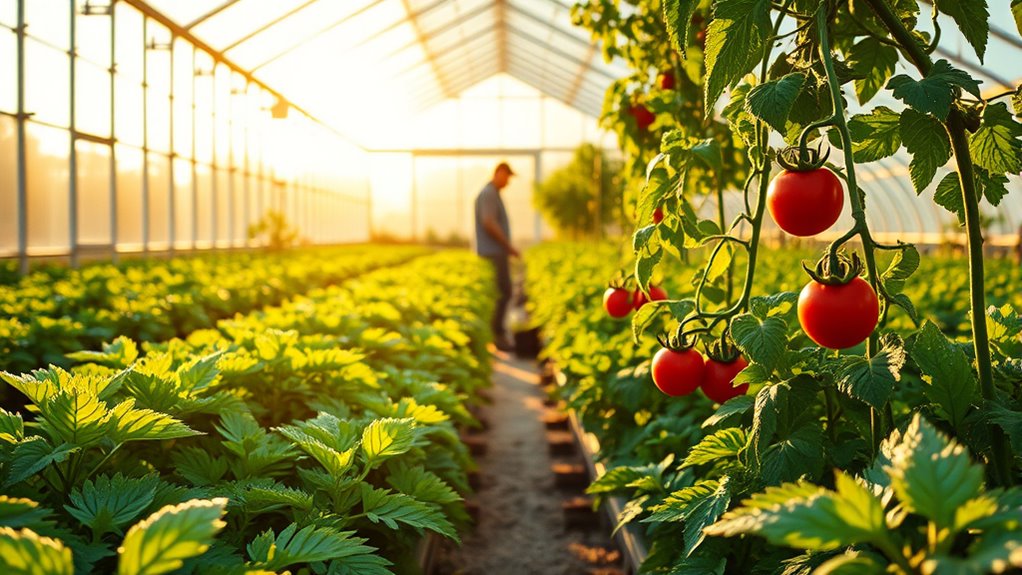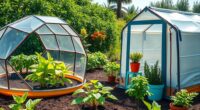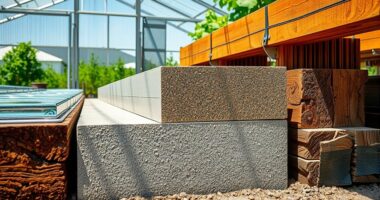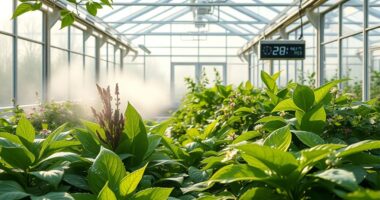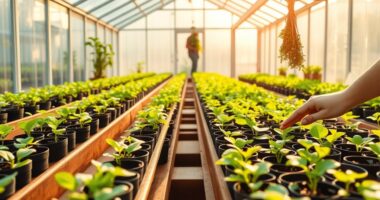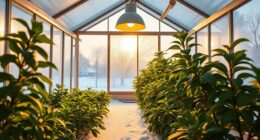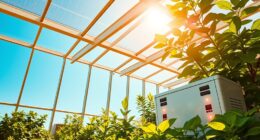Greenhouses extend your growing season by allowing you to start planting earlier in spring and harvest later in fall. They create controlled environments that protect plants from harsh weather, pests, and diseases, boosting crop yields by up to 60%. With better temperature and humidity control, you can optimize plant growth and health. By maximizing productivity in tight spaces, greenhouses also let you cultivate a variety of exotic crops. There’s much more to explore about greenhouse gardening!
Key Takeaways
- Greenhouses capture solar heat, allowing for earlier planting in spring and extended growing into fall.
- They provide protection from frost, enabling crops to thrive in cooler temperatures.
- Controlled environments boost plant growth, increasing harvest yields by up to 60%.
- Proper temperature and humidity management optimize conditions for plant development year-round.
- Greenhouses allow for the cultivation of exotic crops that may not survive in local climates.
Understanding the Benefits of Greenhouses
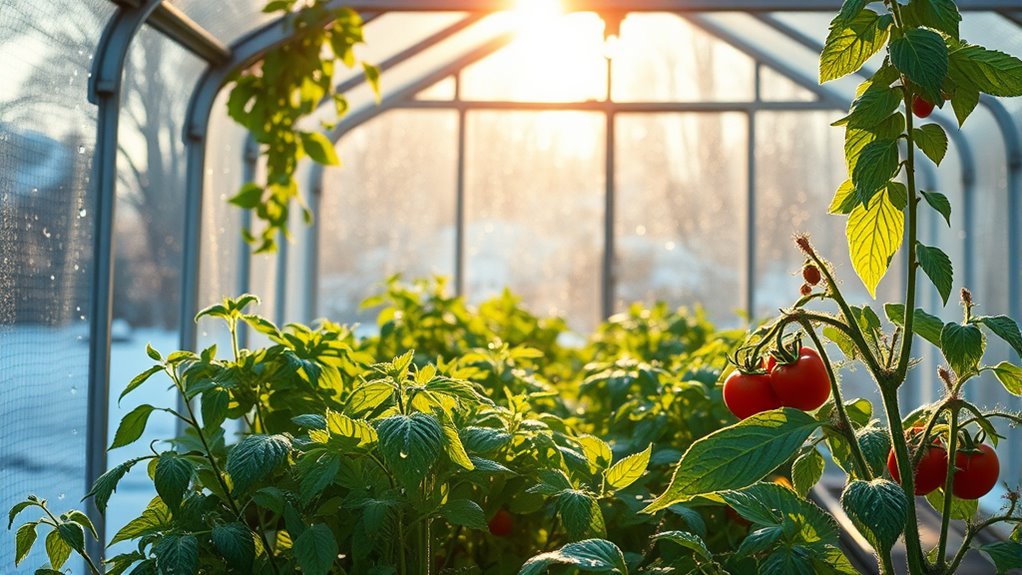
When you think about extending your growing season, greenhouses offer a range of benefits that can transform your gardening experience.
They can boost your harvest by up to 60%, allowing you to start earlier in spring and finish later in fall. With a controlled environment, you can regulate temperature, humidity, and light, ensuring ideal growth.
Boost your harvest by up to 60% with a greenhouse, allowing earlier springs and extended falls for ideal plant growth.
Greenhouses protect your plants from extreme weather, pests, and diseases, reducing the need for pesticides. Plus, they conserve water by minimizing evaporation.
The enclosed space maximizes your productivity, letting you grow more plants in tighter spaces. This means higher yields and the ability to cultivate exotic crops that wouldn’t thrive outdoors.
Types of Greenhouses for Season Extension
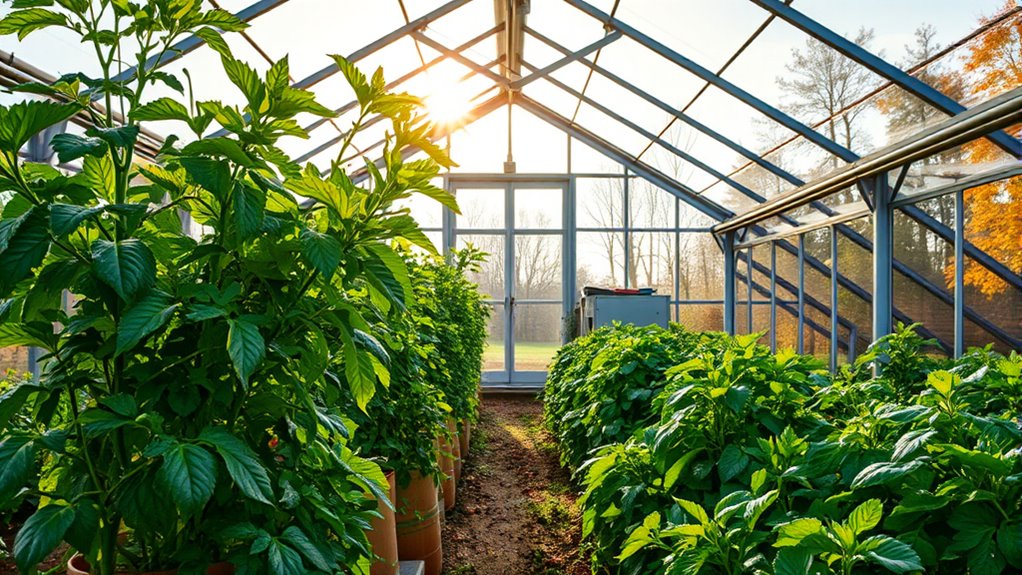
Greenhouses come in various types, each designed to help you extend your growing season effectively.
Cold frame greenhouses are simple structures that protect your plants from frost while capturing solar heat.
Hoop houses, with their affordable tunnel shape, utilize PVC pipes and plastic for basic protection.
If you’re looking for something larger, high tunnels provide walk-in space ideal for commercial growing and better ventilation.
Traditional greenhouses, made with glass or polycarbonate panels, offer maximum climate control.
Lean-to greenhouses save space by attaching to existing buildings, ensuring good sun exposure.
Depending on your needs and budget, each type can help you enjoy a longer growing season and protect your plants from unpredictable weather.
How Temperature Control Impacts Growth
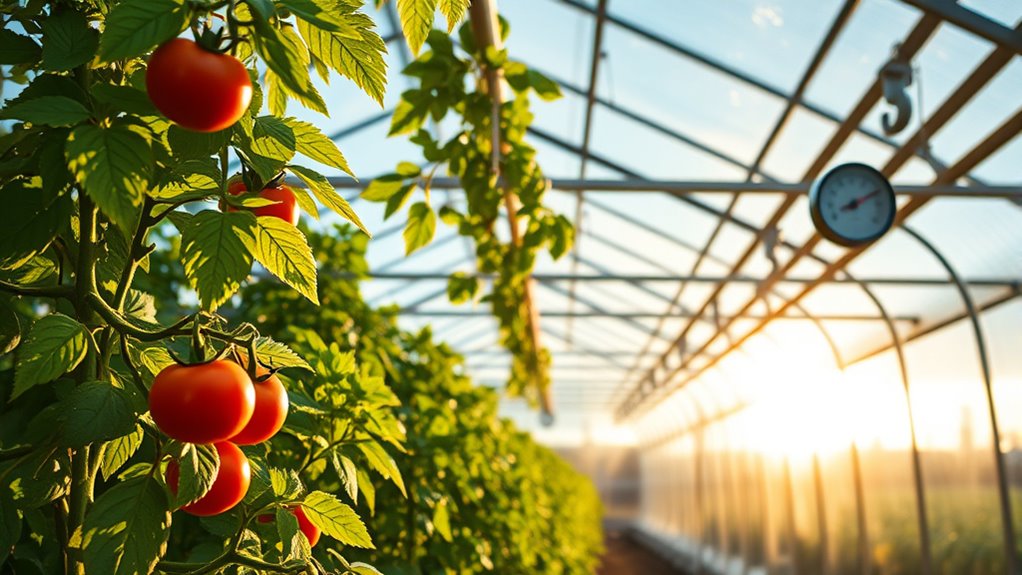
Since maintaining the right temperature is essential for plant growth, understanding how temperature control impacts growth can greatly enhance your gardening success.
Most greenhouse crops thrive between 64-75 ºF. When temperatures fall below this range, cold-sensitive plants slow in growth and may delay flowering. Conversely, high temperatures can cause heat damage, affecting both development and yield.
Proper temperature control boosts photosynthesis, enhances respiration rates, and improves disease resistance, ultimately leading to better crop quality. Techniques like heating systems in winter and cooling methods in summer help maintain ideal conditions.
The Role of Ventilation in Greenhouse Health
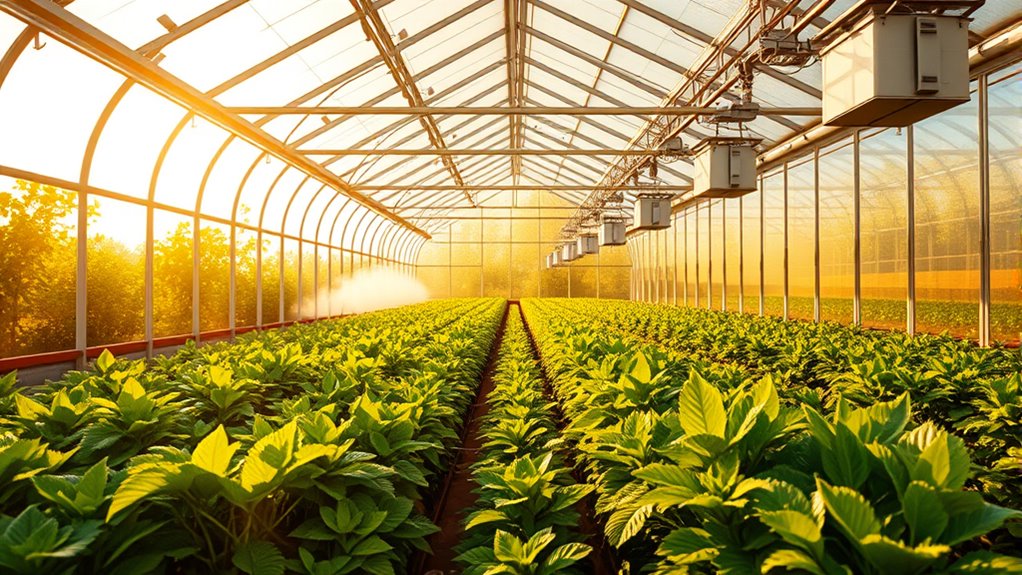
Maintaining an ideal temperature is vital for plant growth, but ventilation plays an equally important role in greenhouse health. Proper ventilation regulates temperature, preventing overheating and thermal stress on your plants.
It also controls humidity, reducing the risk of condensation and fungal diseases. You’ll guarantee optimal CO2 levels for photosynthesis and O2 for respiration through effective gas exchange.
Air circulation, aided by circulation fans, distributes fresh air evenly, enhancing your plants’ microclimate. This helps prevent diseases and pests, reducing your need for pesticides.
Using Shading Options for Optimal Light Regulation
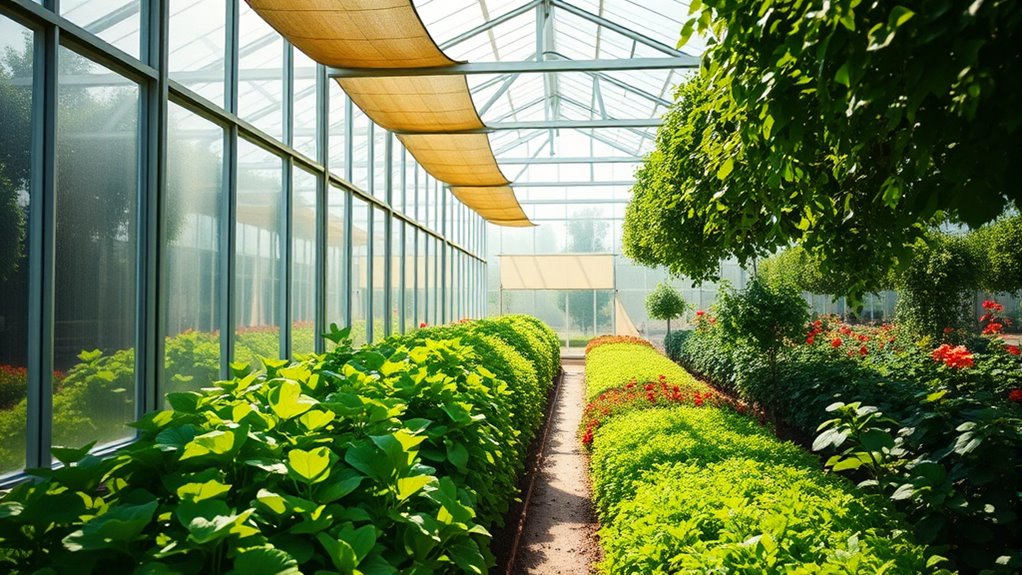
When it comes to optimizing light in your greenhouse, choosing the right shading materials is essential.
Different techniques, like shade cloth and roller screens, can greatly benefit your plants by regulating heat and light exposure.
Let’s explore how you can implement these options effectively to enhance your growing conditions.
Types of Shading Materials
To optimize light regulation in your greenhouse, choosing the right shading material is essential.
Aluminet is a cost-effective, reflective option that cools by reflecting heat, while black nylon filters light without heat reflection.
Polyethylene offers excellent UV protection at an affordable price, and polypropylene stands out for its durability, making it perfect for windy conditions.
If you need sturdiness with varied light transmission, polyester is a great choice.
Consider using HDPE shade cloths for breathability and effective temperature reduction.
When installing, you can opt for exterior or interior methods, ensuring your plants receive ideal light while maintaining a comfortable environment.
Each material has unique properties to match your specific greenhouse needs.
Benefits of Shade Regulation
While shade regulation might seem like a secondary consideration, it plays an essential role in creating ideal growing conditions for your plants. By reducing heat stress, shade regulation lowers the internal temperature of your greenhouse, preventing damage from excessive heat. This also leads to energy savings, as you’ll rely less on cooling systems.
Consistent shading maintains temperature stability, reducing stress on your plants caused by fluctuations. Additionally, shade nets optimize light levels for photosynthesis, preventing sunburn on leaves and enhancing crop quality. They’re versatile, allowing you to adjust shading based on your plants’ needs.
Implementing Shading Techniques
How can you guarantee your plants thrive in varying light conditions? Implementing effective shading techniques is key. Here are four options to evaluate:
- External shade netting: Covers the greenhouse roof, reducing sun exposure.
- Internal shade netting: Fixed inside, allowing you to control light levels precisely.
- Shading compounds: Whitewash applied to glazing offers a cost-effective solution.
- Retractable shade curtains: Adjusts light levels dynamically to meet plant needs.
These methods help manage light intensity, preventing damage while enhancing photosynthesis.
Insulation Techniques for Heat Retention
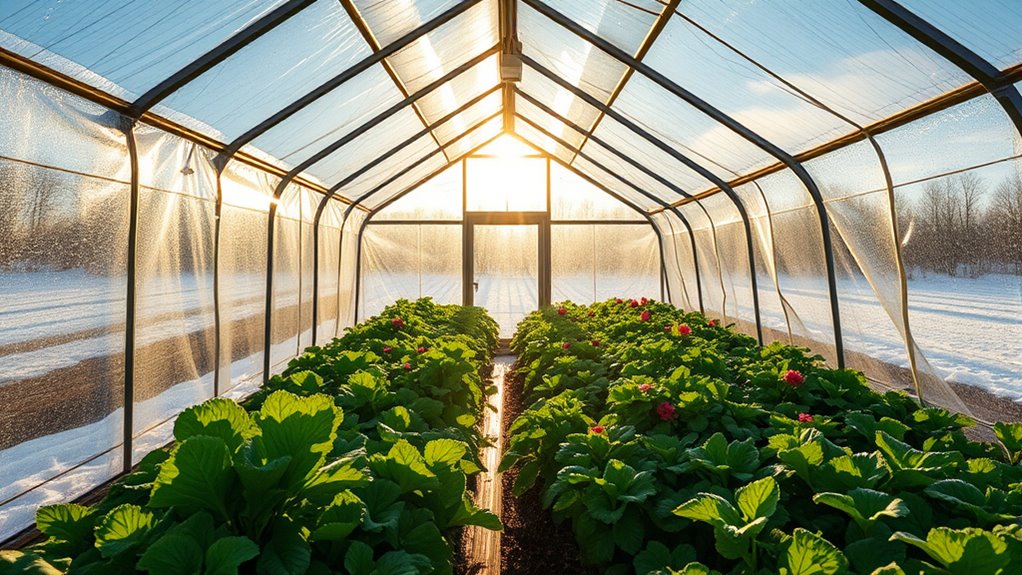
To keep your greenhouse warm, you’ll want to focus on effective insulation techniques.
Selecting the right insulating materials, utilizing thermal mass, and managing ventilation can considerably enhance heat retention.
Thermal Mass Utilization
Thermal mass plays an essential role in maximizing heat retention within greenhouses, acting as a natural buffer against temperature fluctuations.
By utilizing materials that absorb and release heat, you can create a more stable environment for your plants. Incorporating thermal mass techniques can significantly enhance your greenhouse’s efficiency.
Consider these effective methods to implement thermal mass:
- Water Barrels: Stack large drums of water to form a ‘water wall’ that captures heat.
- Brick or Stone Flooring: Use these materials for flooring, enhancing thermal mass and adding visual appeal.
- Phase Change Materials (PCMs): Integrate PCMs into walls for superior heat storage capabilities.
- Aquaponics Systems: Utilize fish tanks to double as thermal mass, providing a unique solution.
These techniques help maintain ideal temperatures, promoting plant growth year-round.
Insulating Materials Selection
Maximizing heat retention in your greenhouse goes hand in hand with selecting the right insulating materials. For effective insulation, consider double-walled polycarbonate, which balances insulation and light transmission.
If you’re looking for affordability, single-wall polyethylene is a common choice in warmer climates, though its insulation isn’t the best. For superior thermal performance, double glass is ideal but comes at a higher cost.
You might also explore double-layered cladding or bubble insulation film that can enhance heat retention while still allowing light in.
Thermal curtains and climate screens can greatly minimize heat loss at night.
Ventilation and Airflow Management
While heat retention is essential for extending your greenhouse’s growing season, effective ventilation and airflow management play an equally important role.
Here’s how you can optimize these systems:
- Natural Ventilation: Utilize roll-up sides or opening roofs to let hot air escape while fresh air flows in.
- Mechanical Ventilation: Install horizontal airflow fans for even air distribution and cost-effective climate control. Regular maintenance of these fans is crucial for optimal indoor air quality, as well as ensuring proper airflow around the unit. Maintaining the correct refrigerant levels in cooling systems can further enhance the climate control in your greenhouse.
- Forced-Air Ventilation: Use fans to exhaust hot air and draw in cooler air, keeping temperatures consistent.
- Positive Pressure Ventilation: Draw cool air in through perforated tubes, especially useful in hot environments. Implementing these techniques can create a balanced environment that promotes healthy plant growth.
Additionally, color accuracy in your greenhouse setup can also influence plant growth and health by ensuring proper light conditions.
Choosing the Right Plants for Your Greenhouse
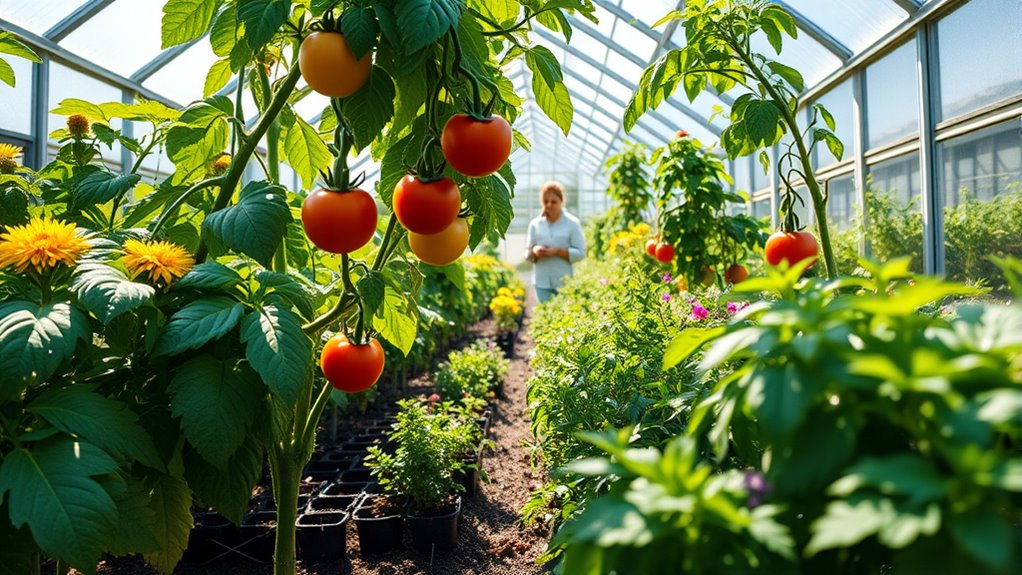
How can you guarantee your greenhouse thrives year-round? Start by selecting the right plants.
For fruit-bearing options, consider bananas and guavas, which love warm conditions, or blueberries and strawberries for their antioxidant benefits. Drinking celery juice can also be a fantastic addition as it enhances hydration and nutrient absorption. Chia seeds, known for their high fiber content, can promote satiety and help manage cravings when included in your diet.
If vegetables are your focus, cucumbers and string beans grow well in vertical spaces, while tomatoes and chili peppers yield consistently. Leafy greens like spinach and kale regenerate quickly, making them smart choices for continuous harvest. Historically, chia seeds were also recognized for their high nutritional value and ability to enhance energy levels. Chia seeds are particularly valued for their high omega-3 content, which supports heart health.
Don’t forget herbs like garlic, always in demand. For a touch of beauty, explore exotic plants like orchids or bromeliads, which thrive in stable climates. Additionally, incorporating plants like celery juice can enhance hydration and nutrient content in your greenhouse.
Maintaining Ideal Conditions for Plant Care

To keep your plants thriving, you’ll need to manage temperature and humidity effectively.
It’s essential to maintain a temperature range between 18°C and 24°C while ensuring humidity levels hover around 80%.
Temperature Management Techniques
Maintaining ideal temperature conditions in a greenhouse is essential for plant health and productivity. To achieve this, consider these effective temperature management techniques:
- Supplemental Heating: Use systems like floor heating to keep plants warm during colder months.
- Evaporative Cooling: Implement moist pads to cool incoming air in hot, dry climates.
- Natural Ventilation: Open doors and windows to let warm air escape, allowing cool air to circulate.
- Shade Curtains: Block 30-50% of sunlight during peak hours to minimize heat buildup.
Regular monitoring of your greenhouse temperature is vital.
Adjustments may be needed based on seasonal changes, ensuring your plants thrive throughout the year in their ideal environment.
Humidity Control Strategies
While managing humidity levels in your greenhouse may seem challenging, it’s essential for ensuring healthy plant growth and preventing diseases. High humidity can lead to mold, while balanced levels optimize photosynthesis and reduce plant stress. Here are some effective strategies to maintain ideal humidity:
| Strategy | Benefits | Tools Needed |
|---|---|---|
| Humidifiers/Dehumidifiers | Adjusts moisture levels | Humidifier, Dehumidifier |
| Natural Ventilation | Exchanges humid air | Vents, Fans |
| Irrigation Management | Prevents overwatering | Timers, Soil Moisture Sensors |
| Automation | Provides real-time control | Sensors, Automation Systems |
Implementing these methods will help you create a thriving environment for your plants, enhancing growth and yield. Additionally, maintaining ideal humidity levels is important for emotional regulation, as an environment that supports plant health can also foster a positive atmosphere for those tending to it. Understanding the financial considerations involved in greenhouse maintenance can further enhance your gardening experience.
Cost Considerations and Energy Efficiency

Investing in a greenhouse can be a rewarding decision, but you need to contemplate both initial costs and ongoing energy efficiency to maximize your benefits.
Here are some key cost considerations:
- Initial Investment: Expect to pay between $1,000 and $4,500, depending on size and materials.
- Utilities and Equipment: Adding plumbing and electricity can boost your costs considerably.
- Size and Material: Larger structures and glass materials can run up to $45 per square foot.
- Energy Efficiency Measures: Insulating properly and sealing leaks can cut heating bills by 5-10%.
Being mindful of these factors helps guarantee you get the most out of your greenhouse while keeping expenses in check.
Sustainable Practices in Greenhouse Gardening
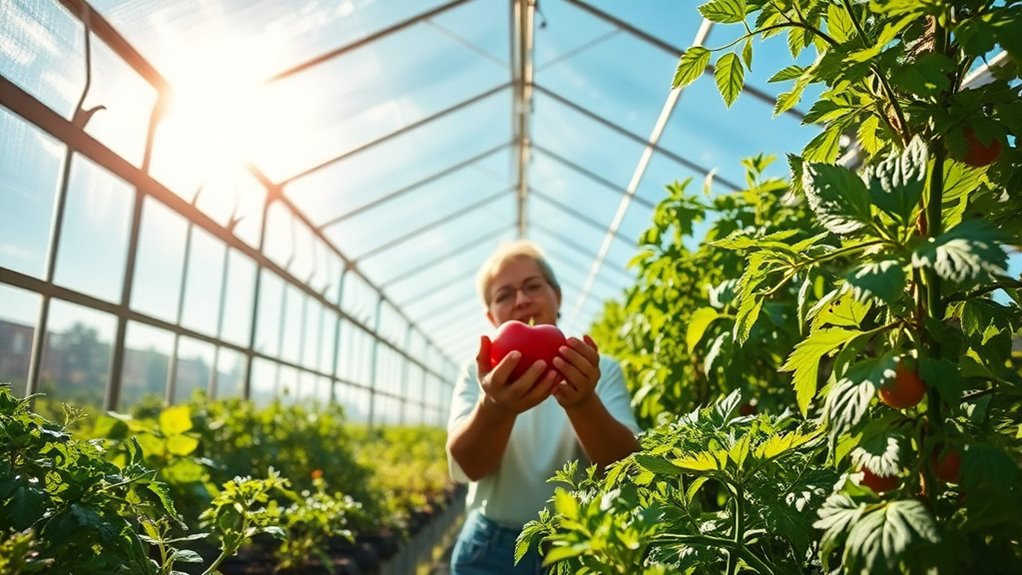
Sustainable practices in greenhouse gardening not only enhance your growing experience but also contribute to environmental conservation. By implementing eco-friendly methods, you can create a thriving garden while minimizing your ecological footprint. Additionally, using self-watering planters can significantly reduce water usage while maintaining plant health. Incorporating rainwater collection systems can further improve your water conservation efforts. Freshly squeezed juice, for example, is best consumed within 2-3 days to ensure optimal freshness and nutrient retention. Utilizing solar energy for greenhouse heating can further enhance sustainability while reducing reliance on fossil fuels.
| Water Conservation | Energy Efficiency | Natural Pest Control |
|---|---|---|
| Drip irrigation systems | Low-emissivity glass | Beneficial insects |
| Rainwater collection | Passive heating designs | Organic deterrents |
| Soaker hoses | Bamboo frameworks | Integrated pest management |
Using durable materials and composting kitchen scraps further supports sustainability. By focusing on these practices, you’ll enjoy a productive garden year-round while protecting precious resources and promoting a healthier ecosystem.
Frequently Asked Questions
What Are the Ideal Greenhouse Materials for Different Climates?
When choosing greenhouse materials, consider your climate.
For hot and humid areas, opt for polycarbonate panels and aluminum frames, ensuring good insulation and pest protection.
In temperate climates, glass or polycarbonate with automated ventilation works best.
For cold climates, focus on polycarbonate walls and steep roof pitches to handle snow.
Regardless of your location, galvanized steel frames and insulated materials are essential for durability and stability in all weather conditions.
How Do I Choose the Right Size Greenhouse for My Needs?
To choose the right size greenhouse for your needs, first assess your available space and budget. Measure the area, allowing for maintenance access, and consider your gardening goals.
Think about the plant varieties you want to grow and any storage requirements. If you plan for year-round gardening, factor in local climate conditions.
Finally, research local zoning laws to guarantee your greenhouse complies with regulations. This way, you’ll find the perfect fit for your gardening ambitions.
Can Greenhouses Be Built DIY, or Should I Hire Professionals?
Picture your garden as a canvas, waiting for you to paint it with vibrant blooms.
You can build a greenhouse yourself or hire professionals. If you’ve got some carpentry skills and a DIY spirit, constructing it yourself offers flexibility and customization.
However, if you want to save time and guarantee everything’s built to last, hiring experts might be the better choice.
Weigh your options, and let your green thumb flourish!
What Are Common Pests in Greenhouses, and How Can I Prevent Them?
Common pests in greenhouses include aphids, whiteflies, thrips, fungus gnats, and spider mites.
To prevent infestations, use insect screens on vents, maintain ideal temperature and humidity, and keep your greenhouse clean.
Regularly inspect your plants and soil for early signs of trouble.
You can also grow pest-resistant varieties and introduce beneficial insects like predatory mites to control pests naturally.
Implementing these strategies will help keep your plants healthy and thriving.
How Do I Transition Plants From Greenhouse to Outdoor Conditions?
As the sun rises, painting the sky with promise, you’re ready to shift your cherished plants outdoors.
Start by gradually exposing them to the elements over 5-7 days, shielding them from harsh sunlight and wind. Monitor temperatures, ensuring they’re just right.
Increase their outdoor time daily, introducing direct sunlight gently. If nighttime chills threaten, bring them back inside or cover them.
This careful dance prepares your plants for their new home under the open sky.
Conclusion
Incorporating a greenhouse into your gardening routine can truly transform your growing season. Did you know that greenhouses can extend your growing period by up to 6 months? Imagine harvesting fresh tomatoes in December when others are bundled up indoors! By understanding how to optimize temperature, ventilation, and light, you can create the perfect environment for your plants. So, why wait? Immerse yourself in greenhouse gardening and enjoy a bountiful harvest all year round!
